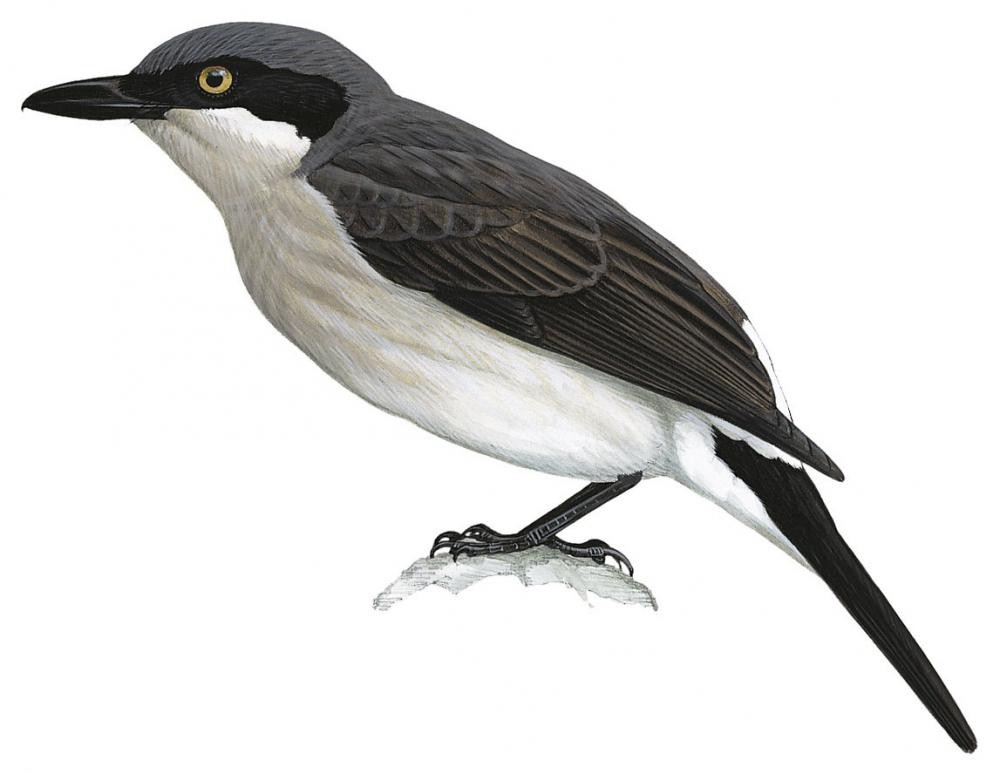Malabar Woodshrike / Tephrodornis sylvicola

Malabar Woodshrike
SCI Name:
Protonym: T[ephrodornis] Sylvicola MadrasJ.Lit.Sci. Vol. 10, N° 25 p. 236-237
Taxonomy: Passeriformes / Vangidae / Tephrodornis
Taxonomy Code: malwoo1
Type Locality: Malabar Coast of western India.
Author: Jerdon
Publish Year: 1839
IUCN Status: Least Concern
DEFINITIONS
TEPHRODORNIS
(Vangidae; Ϯ Large Woodshrike T. virgatus) Gr. τεφρωδης tephrōdēs like ashes, ash-coloured < τεφρα tephra ashes; ορνις ornis, ορνιθος ornithos bird; "Genus, TEPHRODORNIS. Rostrum validum, abrupte aduncum; plumæ capistri rigidæ recumbentes et nares abscondentes. Pedes debiles, graciles; tarsus halluce longior; digiti laterales inæquales; ungues parvi. Alæ mediocres latæ, oblique rotundatæ. Cauda mediocris, æqualis vel lævissime bifurca. Type.— Lanius virgatus, TEMM. Pl. Col., 256." (Swainson 1832); "Tephrodornis Swainson, 1832, in Swainson and Richardson, Fauna Bor.-Amer., 2 (1831), p. 482. Type, by original designation and monotypy, Lanius virgatus Temminck = Lanius gularis Raffles." (Deignan in Peters 1960, IX, 219). Some authors suggest that this genus, together with Megabyas, Bias, and Hemipus, be separated in a new family,Tephrodornithidae.
Synon. Creurgus, Keroula, Tenthaca, Tephrolanius.
sylvicola
L. silvicola inhabiting woods, sylvan < silva woodland, forest; -cola -dweller < colere to inhabit.
● ex “Ynambú listado” of de Azara 1802-1805, no. 331 (syn. Crypturellus undulatus).
Sylvicola
L. silvicola inhabiting woods, sylvan < silva woodland; -cola -inhabitant < colere to inhabit.
• (Columbidae; syn. Columba † Yellow-eyed Pigeon C. eversmanni) "I rod'. Columba L. A) Rupicola. 1. Columba livia Briss. (C. neglecta Sewerzow). ... 2. Columba rupestris Pall. B) Sylvicola. 3. Columba fusca Pall. (C. Eversmanni Bp. = C. fusca, β brachyura Sew.). 4. Columba œnas Briss." (Bogdanov 1881) (OD per Laurent Raty).
• (Phylloscopidae; syn. Phylloscopus † Wood Warbler P. sibilatrix) "GENUS 10. SYLVICOLA. Nobis. Sp. 1. S. TROCHILUS. Linnæus. ... Sp. 2. S. SIBILATRIX. Bechstein. ... Sp. 3. S. RUFA. Latham." (Eyton 1836); "Sylvicola Eyton, 1836, Cat. British Birds, p. 13. Type, by tautonymy and subsequent designation (G. Gray, 1855, Cat. Genera Subgenera Birds Brit. Mus., p. 34), Sylvia sylvicola Montagu, 1798 = Motacilla sibilatrix Bechstein, 1793." (JAJ 2021).
• (Parulidae; syn. Setophaga † Northern Parula S. americana) "G. SYLVICOLA. Swains. in Zool. Journ. No. 10. 38. Sylvicola pusilla. Wilson iv. pl. 28. f.1. 39. Sylvicola Blackburnia. Wilson iii. pl. 23. f. 3. 40. ——— citrinella. Wilson ii. pl. 15. f. 5. 41. ——— flavicollis. Wilson ii. pl. 13. f. 6. 41. ——— inornata. ... This, and all the foregoing species, were collected near Vera Ceuz, and seem to be young birds." (Swainson 1827 (Philos. Mag.)); "SYLVICOLA. ... Type. Sylvia pusilla. Wilson, 4. pl. 28. f. 3. This genus, which will comprise exclusively the greatest part of the Sylviæ of North America, is strictly typical. The formation of the wing affords an unerring mark of distinction. The nearest approach I have yet seen towards this extensive group is made by another, which has just been characterized by Mr. Vigors and Dr. Horsfield, under the name of Zosterops" (Swainson 1827 (Zool. Journ.)); "Sylvicola (not of M. Harris, 1776) Swainson, Phil. Mag., (n. s.), 1, No. 6, p. 433, June, 1827—type, by subs. desig. (Swainson, Zool. Journ., 3, No. 10, p. 169, Sept., 1827), Sylvia pusilla Wilson [= Parus americanus Linnaeus]." (Hellmayr, 1935, Cat. Birds Americas, Pt. VIII, p. 347).
Var. Silvicula.
• (Parulidae; syn. Setophaga † Myrtle Warbler S. coronata) "SYLVICOLA, Swains. (1827). Ficedula, (Briss.) Cuv. (1799-1800). Sylvia, Lath. Curruca, Less. Motacilla, Gm. Regulus, p. Cuv. (1817). Phyllopneuste, (Meyer) 2nd div. Boie. S. coronata, (L.) Swains. Edw. t. 255." (G. Gray 1841); "Sylvicola "Swainson" G. Gray, 1841, List Genera Birds, 2nd ed., p. 32. Type, by original designation, S. coronata, i.e. Motacilla coronata Linnaeus, 1766." (JAJ 2021).
UPPERCASE: current genus
Uppercase first letter: generic synonym
● and ● See: generic homonyms
lowercase: species and subspecies
●: early names, variants, mispellings
‡: extinct
†: type species
Gr.: ancient Greek
L.: Latin
<: derived from
syn: synonym of
/: separates historical and modern geographic names
ex: based on
TL: type locality
OD: original diagnosis (genus) or original description (species)












